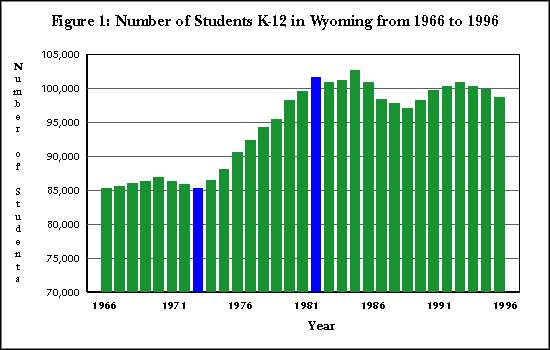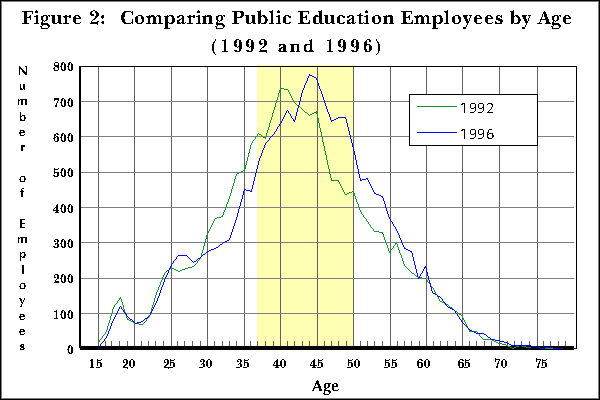The importance of public education for our children is a common theme lately. As the new school year gets into full swing, there have been numerous reports on the state of the education system both on the national and state levels. Statistics show that the number of students is increasing nationally and a possible shortage of teachers could occur in the near future. These factors have produced concerns about funding, overcrowding, classroom size, teacher shortages and a host of other topics. Some of these topics are examined in this month’s Wyoming Labor Force Trends article. This article focuses on the public education sector of the Wyoming education system. It is an exploratory study of employees in the Wyoming public education system from kindergarten through high school (K-12). The public education sector covers the whole state and affects every community in the state. The public education sector also accounts for about 10 percent of Wyoming’s total covered employment (please refer to the Glossary). Private elementary and secondary schools as well as colleges and the university are not included in the data presented in this article. The state’s entire public education system, K-12, was used for the research, but the same type of research could be done on a local level (district, county or region). This research design could be used for any industry at any level of geographic detail.
Table 2: Public Education Employees Compared
Aging Employment in the Wyoming Public Education System K-12 Employees in Wyoming’s education system are older and the age distributions for school employees are skewed heavily toward the middle age group, those 37-50 years old in 1996. What caused the high levels of employees in certain age groups? How does this affect school budgets? What does this mean for those seeking careers in the Wyoming education system? The 37-50 year old age group is the main focus of this report. Table 2 shows that the proportion of workers ages 35-54 in education, compared to all workers in the state, is larger than expected. The largest number of public school employees in 1996 falls in the age range 37-50 (9,970 or 48.5%). The high quantity of employees in this age group shows a direct correlation to the increase in school enrollment in the 1970’s and early 1980’s. There was a large increase in school enrollment in Wyoming from 1973-1982. The number of students enrolled K-12 in Wyoming rose from 85,391 in 1973 to 101,665 in 1982 (see Figure 1). Assuming that a majority of school employees are hired in their mid-twenties, the age of 25+/-2 years is used as a reference age range. If we assume that more employees were hired between the years of 1973 and 1982 to handle the increased workload, and that the average age of the new hires was 23-27, this group would be 37-50 years old in 1996 (see Figure 2). 
The Effect of Retirement on the Wyoming Education Industry According to the Handbook of the Wyoming Retirement System 1996, “Full-time or regular part-time employees of the State, public school districts and institutions of higher learning are required to join [the Wyoming Retirement System] at the time of employment.”. Under the Age and Eligibility sections of the handbook, “Members qualify for a retirement benefit if they are 50 years old and have at least 48 months of service, or they may retire at any age with twenty-five years of service. Normal retirement age, for purposes of calculating retirement benefits, is age 60. Retirement before age 60 is considered to be an early retirement. Normal retirement would also occur when members can qualify for the Rule of 85 (years of service plus age equal 85). Under the Rule of 85, there is no actuarial reduction for retirement prior to age 60 (normal retirement age). However, service credit is allowed only for years actually worked. No service from either a prior service credit purchase or service purchased by a city, town or county pursuant to W.S. 9-3-405 will be counted for eligibility for retirement under the Rule of 85.” As school employees age, payrolls increase. This is due to the fact that older workers with tenure receive higher salaries. The retirement trend should come into play 10 to 15 years from now, due to the ages of current employees and the “Rule of 85”. As an increased number of older employees retire, new/younger employees tend to be hired to replace them, at lower salaries. Hiring new employees should then bring expenditures down in most areas of the state. Budgets should be reduced through the natural cycle of retirement. Since 1982, the level of school enrollment has not changed dramatically. There have been minor fluctuations, as in the late 1980’s, but nothing like the increase in the late 1970’s and early 1980’s. This leveling of school enrollments has caused the employment needs to even out since the early eighties. Therefore, the primary source of job openings in education are replacement openings and not growth openings. Replacement openings are openings created when an employee is fired, retires, quits or dies. Replacement openings due to retirement seem to be the primary form of openings and will continue to be as long as there is not an increase or decrease in school enrollment. The retirement cycle will have a positive impact on those seeking entry into the Wyoming education system. In five years, an above-normal retirement cycle should begin, caused by the 37-50 age group reaching the retirement age. In 2002, this group will be 43-56 years old. Aging/retirement will continue and reach a peak between the years of 2005 and 2015. This retirement process will mean numerous additional replacement openings compared to the current levels. The following conclusions about the education segment of the Wyoming labor force can be drawn from the data:
Employees = The Number of School Employees in the Sample
| |||||||||||||||||||||||||||||||||||||||||||||||||||||||||||||||||||||||||||||||||||||||||||||||||||||||||||||||||||||||||||||||||||||||||||||||||||||||||||||||||||||||||||||||||

|
| Table of Contents | Labor Market Information | Wyoming Job Network | Send Us Mail |

